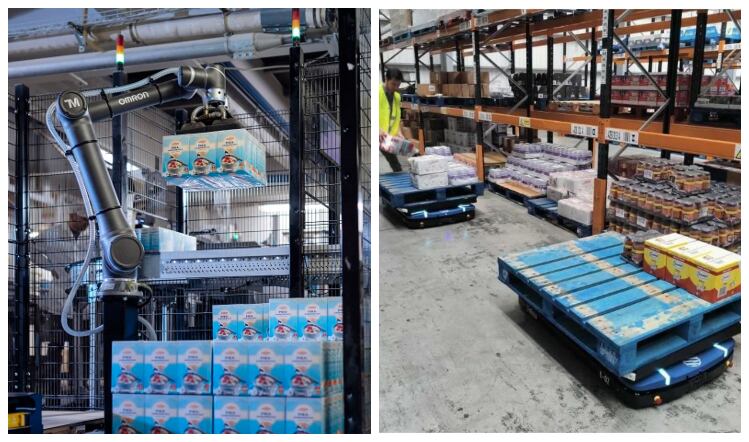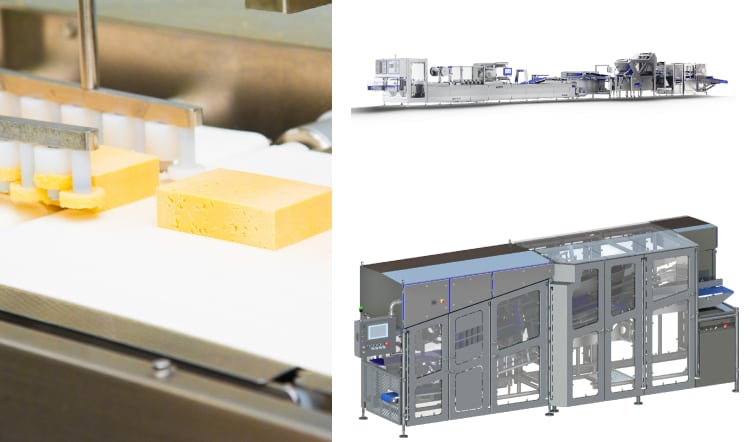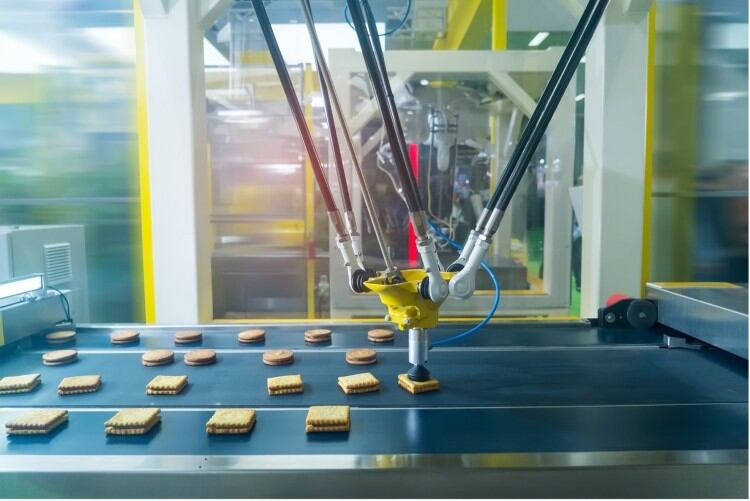Always there, but more of a reason
Speaking with Keith Thornhill, head of food & beverage for Siemens GB&I, he said that robotics in the food and drink industry are nothing new – in fact, Siemens has been working across factory end-of-line automation processes for more than 20 years. However, cost pressures around labour and its availability have accelerated the need to automate more than ever before.
While robot controllers previously needed to be bespoke and complicated – which led to support difficulties and stand-alone functionality – advances in the field mean that installing robots and automation on the production line has become much easier.

“With the advent of processor improvements and integrated communications, all of the mechanical kinematics required for robots can now be achieved with standard PLC [programmable logic controller] control systems so that deployment connectivity and supportability have been simplified,” Thornhill explained.
“The significance of being able to treat a robot like any other control system means it can be ‘plugged in’ to a digitally connected, IOT [Internet of things]-functioning factory in the same way that teams on the ground are trained for. Connecting robots to the wider digital infrastructure in this way also ensures its data can be analysed to provide a more comprehensive picture of the factory floor.”
For those manufacturers still worried about the risk – and cost – of installing robots on their lines, Thornhill pointed out that Siemens has been working for some time to realise the power and impact of ‘digital twins’. By creating an exact digital double of a factory, a manufacturer can, for example, simulate robotic processes or even create a 3D model of the robot itself.
“Digital twin work creates a virtual replica, making it possible to manipulate individual components to see what could work better in practice, as well as to predict performance outcomes and future issues,” Thornhill continued. “All of which improves productivity but also contributes to increased efficiencies sustainability gains in turn.
“However, safety legislation around robotics and automation has got to keep up with technology development if we’re to harness the potential that is required within the food and drink sector.”
Cost pressures and labour shortages has sparked the need for manufacturers to do everything they can to be more efficient and the growth of industrial and collaborative robots (so called ‘cobots’) has had a significant impact of these decisions.

“The introduction of robotics can deliver many benefits. Industrial robots are being used in food processing plants to perform tasks such as slicing, dicing and mixing ingredients,” said Garry Lewis, Omron UK market development manager for food, beverage and commodities.
“Due to the speed and accuracy these robots provide, food manufacturers are seeing the benefits of reduction in wastage, improvements in efficiency and allowing them to process more products in less time. Both industrial and collaborative robots are helping food companies with the ongoing issues of labour shortages.”
One example Lewis gave was the use of cobot palletisers at the end of line packaging area, which allows a manufacturer to redeploy workers to another part of the production process or provide the opportunity to upskill them. Additionally, by taking over repetitive and physically demanding tasks, industrial and collaborative robots can improve working conditions for human workers, leading to a reduction in workplace injuries and a more comfortable working environment.
“Collaborative robots can be used in the food and drink sector to improve food safety,” Lewis continued. “These robots can perform tasks such as inspecting products for defects, ensuring that they meet strict quality standards. This helps to reduce the risk of foodborne illnesses, costly product recalls and reduces the risk of brand damage, whilst ensuring customers receive high-quality products.
“Overall, the growth of industrial and collaborative robots has had a significant impact on the food and drink sector. These robots are improving efficiency, reducing costs, improving food safety, increasing flexibility and improving working conditions. As technology continues to advance, we can expect to see even more innovative uses for robots in the food and drink industry in the future.”
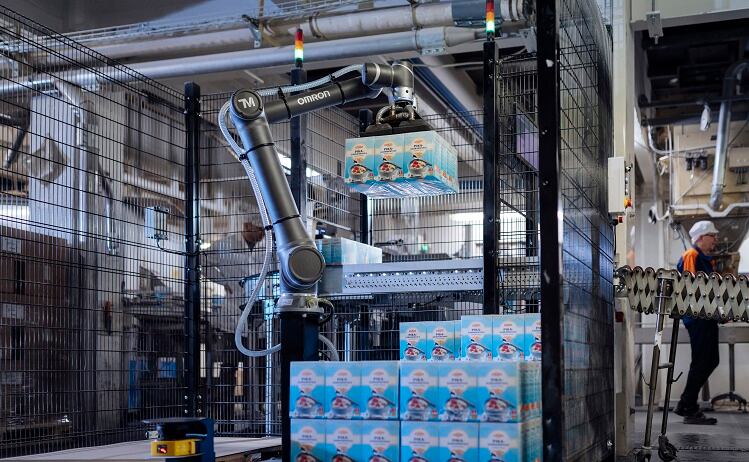
How technology could help enhance worker safer
Worker safety is increasingly playing a major role in the decision making when it comes to automation and robotics in the food factory. What’s more, with the labour pool decreasing, so too does the number of people prepared to perform arduous – even hazardous – tasks in the food supply chain.
Cold storage is a particular area that has drawn some attention as of late, as there is an increasing realisation of the need to limit the length of time that workers spend in the cold before taking a break in warmer areas and of the long-term impacts of heavy manual tasks in cold conditions.
Frazer Watson, vice-president of sales UK/Ireland at iFollow believes that autonomous mobile robots (AMRs) will contribute significantly to efficient and productive use of cold storage, an automated solution that is now not a question of luxury, but one of need. But the adoption of such technology in these environments is marred by sub-zero temperatures that are likely to embrittle and otherwise degrade materials in automated machinery.
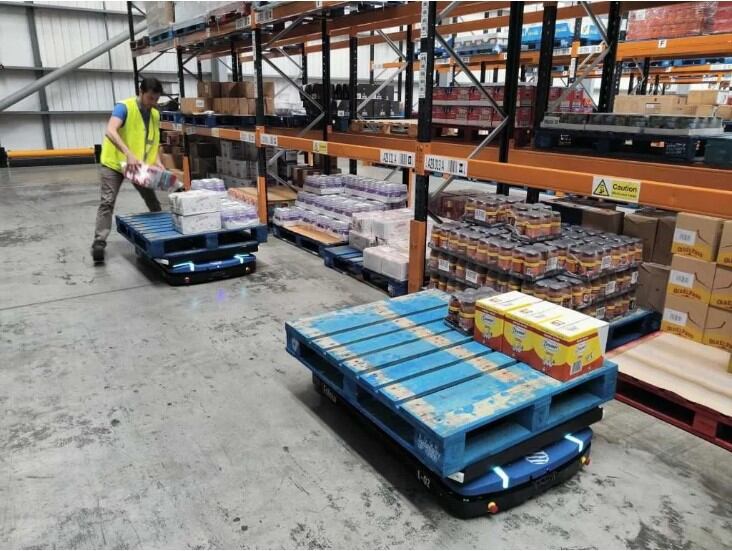
“Not all AMRs can work in cold storage,” said Watson. “iFollow, however, has a range of robots for cold chain logistics that transport from 300kg to 1500kg payload down to -25°C and is specific to the cold store environment. This is due to its approach to safeguarding electronics and batteries.
“Temperature of key electronic components are regulated by an iFollow-developed servo system which eliminates condensation (and therefore icing) at temperatures as low as -25° – a particular issue when moving regularly between cold and temperate spaces.”
The use of AMRs eliminates the need for ride-on vehicles in cold storage areas, which in turn removes the threat of injury to workers – also, specialised cold-store standard trucks aren’t cheap. In iFollow’s example, a simple user interface also allows operators to command the AMRs even while wearing heavy gloves or having to remove them for extend period to input complex instructions.
“An ability for an AMR to carry two roll cages at once, to a maximum load of 1,500kg offers an advantage, particularly in the cold store environment because it reduces the number of times doors have to be opened and closed,” Watson continued. “That not only reduces energy loss and minimises the potential for condensation, but also reduces the hazard from the typically fast acting cold store doors.”
Why are food and beverage manufacturers slow to uptake technology?
It's already been widely demonstrated that robots provide much more benefit than detriment for a food business. So, what is it that is preventing them from taking the dive and fully embracing a future of automation?
George Thompson, chairman of the British Automation & Robot Association and robotic systems sales manager at Güdel UK, said: “I think the biggest one is courage. Quite a few businesses, particularly the smaller companies, would say ‘we’ve always managed to get people’. Now, they can’t get people and that’s the driver [for robotics adoption] because of the Brexit issues going on and we’ve also got the fact that the younger generation don’t want those [food factory] jobs anymore.
“It’s getting harder and harder to find operative for the line, so sooner or later we’re going to have to address these issues – issues we’ve been talking about for years and years. I’ve been fortunate enough to ‘play’ with robots for over 20 years and the things we are talking about then we’re talking about now.”
The issues he referred to are the fears that robots are out to take people’s jobs, the idea that humans will become obsolete as soon as a manufacturer decides to install automation on the production line. Thompson felt that businesses didn’t understand the types of jobs robots would be taking over – the manual handling that requires bending and heavy lifting.
“If the majority of companies actually went through and did a manual handling risk assessment on each individual station and followed the [Health and Safety Executive] guidelines, there would be a lot more automation in the workplace,” said Thompson. “The very first thing that the HSE says is ‘can it be automated?’.”
From the looks of things, robots aren’t here to take our jobs – on the contrary, robots have to create new jobs in more technical positions. But therein lies another problem that is also plaguing the food and drink sector – a lack of skilled workers.
It’s no secret that the industry is struggling to replace its aging workforce and the younger population has no interest in taking roles within the food and drink sector. Thompson believed the blame could be put down to a lack of interest in more practical past times and that the birth of the digital age – and the major proliferation of internet connected devices such as mobile phones and games consoles – mean younger people don’t have the same drive to get ‘stuck in’ to projects, that they have lost their creativity.
A new approach
Instead of trying to capture this audience the same way that enticed the ageing workforce to their roles, manufacturers – and the education system as a whole – need to appeal to this new generation through systems that they already recognise.
“In some ways, yes, we can still use some of the gaming console type solutions with virtual reality and so on and so forth,” explained Thompson. “And I've used quite a lot of that with previous employers. We’ve gone in and made renders of factories and shown people how the system is are going to work. That’s a really cool aspect that maybe we need to show the younger generation to get them switched on.
“It’s not just turning spanners, there’s a finesse to engineering. We still need people to turn spanners, don’t get me wrong – in some ways they are just as important as the people doing the clever bit in the offices – but it’s getting people interested in the engineering aspect and the controls aspect and the whole gambit of problem solving. That’s what we as automation providers are doing.”
Advances in robotics technology are plain to see, as are the reasons behind choosing to automate over trying to hire from a labour pool that is shrinking every day. Only time will tell if, like Thompson suggests, manufacturers will have the courage to take their factories into the future.

